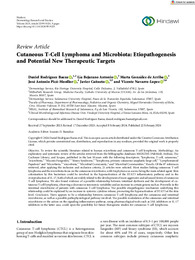Por favor, use este identificador para citar o enlazar este ítem:
https://hdl.handle.net/11000/36540Registro completo de metadatos
| Campo DC | Valor | Lengua/Idioma |
|---|---|---|
| dc.contributor.author | Rodriguez Baeza, Daniel | - |
| dc.contributor.author | Bejarano Antonio, Lía | - |
| dc.contributor.author | González de Arriba, Marta | - |
| dc.contributor.author | Pico-Monllor, JOSE ANTONIO | - |
| dc.contributor.author | Cañueto, Javier | - |
| dc.contributor.author | Navarro López, Vicente | - |
| dc.contributor.other | Departamentos de la UMH::Farmacología, Pediatría y Química Orgánica | es_ES |
| dc.date.accessioned | 2025-05-02T08:35:47Z | - |
| dc.date.available | 2025-05-02T08:35:47Z | - |
| dc.date.created | 2024-02-22 | - |
| dc.identifier.citation | Dermatology research and practice 2024 Feb 22:2024:9919225 | es_ES |
| dc.identifier.issn | 1687-6113 | - |
| dc.identifier.issn | 1687-6105 | - |
| dc.identifier.uri | https://hdl.handle.net/11000/36540 | - |
| dc.description.abstract | Objective: To review the scientific literature related to human microbiota and cutaneous T-cell lymphoma. Methodology. An exploratory and systematic review of the articles retrieved from the bibliographic databases MEDLINE (PubMed), Embase, The Cochrane Library, and Scopus, published in the last 10 years with the following descriptors: "lymphoma, T-cell, cutaneous," "microbiota," "Mycosis Fungoides," "Sézary Syndrome," "lymphoma, primary cutaneous anaplastic large cell," "Lymphomatoid Papulosis" and "Microbiota," "microbiota," "Microbial Community," and "Microbial Communities." Results: Of the 87 references retrieved, after applying the inclusion and exclusion criteria, 21 articles were selected. Most studies linking cutaneous T-cell lymphoma and the microbiota focus on the cutaneous microbiome, with Staphylococcus aureus being the main related agent. Skin colonization by this bacterium could be involved in the hyperactivation of the STAT3 inflammatory pathway and in the overproduction of IL-17, both of which are widely related to the development of more aggressive and advanced forms of cutaneous T-cell lymphoma. We also found evidence of a possible relationship between intestinal dysbiosis and the development of cutaneous T-cell lymphoma, observing a decrease in taxonomic variability and an increase in certain genera such as Prevotella in the intestinal microbiome of patients with cutaneous T-cell lymphoma. The possible etiopathogenic mechanism underlying this relationship could be explained by an increase in systemic cytokine release, promoting the hyperactivation of STAT3 at the skin level. Conclusion: There appears to be a relationship between cutaneous T-cell lymphoma and the cutaneous and intestinal microbiome, as well as a possible pathophysiological pathway involved. The possible modulation of the cutaneous and intestinal microbiome or the action on the signaling inflammatory pathway, using pharmacological tools such as JAK inhibitors or IL-17 inhibitors in the latter case, could open the possibility for future therapeutic studies for cutaneous T-cell lymphoma. | es_ES |
| dc.format | application/pdf | es_ES |
| dc.format.extent | 9 | es_ES |
| dc.language.iso | eng | es_ES |
| dc.publisher | Wiley | es_ES |
| dc.rights | info:eu-repo/semantics/openAccess | es_ES |
| dc.rights | Attribution-NonCommercial-NoDerivatives 4.0 Internacional | * |
| dc.rights.uri | http://creativecommons.org/licenses/by-nc-nd/4.0/ | * |
| dc.title | Cutaneous T-Cell Lymphoma and Microbiota: Etiopathogenesis and Potential New Therapeutic Targets | es_ES |
| dc.type | info:eu-repo/semantics/article | es_ES |
| dc.relation.publisherversion | https://doi.org/10.1155/2024/9919225 | es_ES |

Ver/Abrir:
Cutaneous T-Cell Lymphoma and Microbiota Etiopathogenesis.pdf
1,28 MB
Adobe PDF
Compartir:
 La licencia se describe como: Atribución-NonComercial-NoDerivada 4.0 Internacional.
La licencia se describe como: Atribución-NonComercial-NoDerivada 4.0 Internacional.
.png)